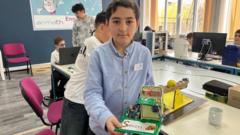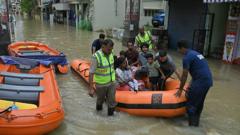The country aims to redefine its economic landscape, competing in the global technology sector.
**Armenia's Bold Vision: Crafting a Silicon Valley in the Caucasus**

**Armenia's Bold Vision: Crafting a Silicon Valley in the Caucasus**
Armenia is cultivating its tech potential through early education and leveraging its historical strengths.
Young Armenians, including nine-year-old Slavik, are already inventors in tech education classes reminiscent of Silicon Valley innovation. In a typical three-storey school in Yerevan, the vibrant capital of Armenia, Slavik showcases his project: a box equipped with three LED lights, fully programmed by him. Maria, a spirited 21-year-old tech coach, praises his skills, highlighting students like Slavik who actively participate in hands-on learning experiences.
Next to Slavik, 14-year-olds Eric and Narek proudly display their smart greenhouse model that monitors temperature and regulates fans via a mobile app. Eleven-year-old Arakel holds up his creative cardboard design for a retractable clothesline that simplifies home chores based on weather. These young innovators are part of Armath, a program launched in 2014 that now boasts 650 labs across the nation, cultivating skills in programming, robotics, and 3D modeling.
Sarkis Karapetyan, CEO of the Union of Advanced Technology Enterprises (UATE), which launched the initiative, believes in Armenia's potential as a tech powerhouse. He notes the rapid growth of tech companies in the country—approximately 4,000 at present. "Our vision is to make Armenia a tech center that contributes significantly to the global market," he states. UATE relies on public-private partnerships, securing funds from private sectors and receiving government support of approximately $2 million annually to run the program effectively.
Historically significant in mathematics and computer science, Armenia is working to leverage its background. Following the establishment of the Yerevan Scientific Research Institute of Mathematical Machines in 1956, the country is now seen as a prime location for tech startups. Noteworthy successes include Picsart, an AI-driven photo editing platform valued at $1.5 billion, indicating the potential of Armenia's tech landscape.
Additionally, Armenia boasts a supportive climate for emerging businesses, ranking as the best place in the South Caucasus for startups. The critical role of the Armenian global diaspora, particularly in the tech sector in the U.S., adds a layer of connectivity that strengthens local entrepreneurs. Venture capital firm SmartGate assists these founders in settling in the U.S., bridging cultural gaps while they test their projects locally before seeking broader markets.
A surge of tech expertise has flowed into Armenia following geopolitical shifts, notably after Russia's invasion of Ukraine. Many Russian IT professionals have relocated to Armenia, enhancing the local workforce with their skills in essential areas like cybersecurity and financial technology. While challenges remain regarding cost-of-living and taxation, Armenian optimism about the thriving tech sector is palpable.
As Samvel Khachikyan of SmartGate suggests, the sector is poised for extensive growth, driven by successes like Service Titan, recently floated on the NYSE and valued over $10 billion. The unfolding journey of Armenia towards becoming a Silicon Valley in the Caucasus is an inspiring narrative of resilience, innovation, and ambition.
Next to Slavik, 14-year-olds Eric and Narek proudly display their smart greenhouse model that monitors temperature and regulates fans via a mobile app. Eleven-year-old Arakel holds up his creative cardboard design for a retractable clothesline that simplifies home chores based on weather. These young innovators are part of Armath, a program launched in 2014 that now boasts 650 labs across the nation, cultivating skills in programming, robotics, and 3D modeling.
Sarkis Karapetyan, CEO of the Union of Advanced Technology Enterprises (UATE), which launched the initiative, believes in Armenia's potential as a tech powerhouse. He notes the rapid growth of tech companies in the country—approximately 4,000 at present. "Our vision is to make Armenia a tech center that contributes significantly to the global market," he states. UATE relies on public-private partnerships, securing funds from private sectors and receiving government support of approximately $2 million annually to run the program effectively.
Historically significant in mathematics and computer science, Armenia is working to leverage its background. Following the establishment of the Yerevan Scientific Research Institute of Mathematical Machines in 1956, the country is now seen as a prime location for tech startups. Noteworthy successes include Picsart, an AI-driven photo editing platform valued at $1.5 billion, indicating the potential of Armenia's tech landscape.
Additionally, Armenia boasts a supportive climate for emerging businesses, ranking as the best place in the South Caucasus for startups. The critical role of the Armenian global diaspora, particularly in the tech sector in the U.S., adds a layer of connectivity that strengthens local entrepreneurs. Venture capital firm SmartGate assists these founders in settling in the U.S., bridging cultural gaps while they test their projects locally before seeking broader markets.
A surge of tech expertise has flowed into Armenia following geopolitical shifts, notably after Russia's invasion of Ukraine. Many Russian IT professionals have relocated to Armenia, enhancing the local workforce with their skills in essential areas like cybersecurity and financial technology. While challenges remain regarding cost-of-living and taxation, Armenian optimism about the thriving tech sector is palpable.
As Samvel Khachikyan of SmartGate suggests, the sector is poised for extensive growth, driven by successes like Service Titan, recently floated on the NYSE and valued over $10 billion. The unfolding journey of Armenia towards becoming a Silicon Valley in the Caucasus is an inspiring narrative of resilience, innovation, and ambition.
















